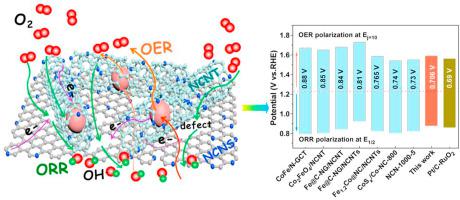当前位置:
X-MOL 学术
›
J. Alloys Compd.
›
论文详情
Our official English website, www.x-mol.net, welcomes your
feedback! (Note: you will need to create a separate account there.)
Electronic structure tuning of FeCo nanoparticles embedded in multi-dimensional carbon matrix for enhanced bifunctional oxygen electrocatalysis
Journal of Alloys and Compounds ( IF 5.8 ) Pub Date : 2021-02-01 , DOI: 10.1016/j.jallcom.2020.157070 Ying Lei , Renxing Huang , Huaming Xie , Dandan Zhang , Xingyong Liu , Yujun Si , Na Li
Journal of Alloys and Compounds ( IF 5.8 ) Pub Date : 2021-02-01 , DOI: 10.1016/j.jallcom.2020.157070 Ying Lei , Renxing Huang , Huaming Xie , Dandan Zhang , Xingyong Liu , Yujun Si , Na Li

|
Abstract It is highly desirable to develop efficient, affordable and durable electrocatalysts to accelerate sluggish kinetics of both oxygen reduction reaction (ORR) and oxygen evolution reaction (OER) for expanding the applications of Zn-air batteries (ZABs). Here, Fe1Co2 alloy nanoparticles (NPs) embedded in N-doped carbon nanotubes/carbon nanosheets (CNTs/CNSs) (denoted as Fe1Co2-NC) were synthesized in situ by pyrolyzing Fe-chitosan, Co-chitosan chelates and urea. It is demonstrated that the interaction of Fe and Co can effectively modulate electronic structure of Fe and Co, in which ionic state cobalt and iron were partially oxidized, contributing to the enhanced intrinsic catalytic activity. Meanwhile, CNTs/CNSs multi-dimensional porous carbon frameworks facilitated adequate exposure of active sites and mass/electron smooth transport. Accordingly, the resulting Fe1Co2-NC catalyst exhibited a high half-wave potential of 0.88 V (vs. RHE) for ORR and a small over potential (0.356 V) for OER, rendering it with an ultralow potential difference (0.706 V) that can rival that of Pt/C + RuO2 (0.69 V). Impressively, the assembled ZABs with Fe1Co2-NC as a cathode catalyst achieved a high open circuit voltage (1.501 V), maximum power density (203.4 mW cm−2), energy density (820.30 W h kg−1) and robust durability with a slightly increased voltage gap (0.058 V) after 209 h charge-discharge test, shedding light on the great application potential.
中文翻译:

嵌入多维碳基体中的 FeCo 纳米粒子的电子结构调整以增强双功能氧电催化
摘要 开发高效、经济且耐用的电催化剂来加速氧还原反应 (ORR) 和析氧反应 (OER) 的缓慢动力学,以扩大锌空气电池 (ZAB) 的应用是非常必要的。在这里,通过热解 Fe-壳聚糖、Co-壳聚糖螯合物和尿素,原位合成了嵌入在 N 掺杂的碳纳米管/碳纳米片 (CNTs/CNSs) 中的 Fe1Co2 合金纳米粒子 (NPs)(表示为 Fe1Co2-NC)。结果表明,Fe和Co的相互作用可以有效地调节Fe和Co的电子结构,其中离子态钴和铁被部分氧化,有助于提高内在催化活性。同时,CNTs/CNSs 多维多孔碳框架促进了活性位点的充分暴露和质量/电子的平滑传输。因此,所得的 Fe1Co2-NC 催化剂对 ORR 表现出 0.88 V(相对于 RHE)的高半波电位和对 OER 表现出小的过电位(0.356 V),使其具有超低电位差(0.706 V),可以与 Pt/C + RuO2 (0.69 V) 相媲美。令人印象深刻的是,以 Fe1Co2-NC 作为阴极催化剂组装的 ZAB 实现了高开路电压(1.501 V)、最大功率密度(203.4 mW cm-2)、能量密度(820.30 W h kg-1)和坚固耐用209小时充放电测试后电压间隙略有增加(0.058 V),揭示了巨大的应用潜力。69 伏)。令人印象深刻的是,以 Fe1Co2-NC 作为阴极催化剂组装的 ZAB 实现了高开路电压(1.501 V)、最大功率密度(203.4 mW cm-2)、能量密度(820.30 W h kg-1)和坚固耐用209小时充放电测试后电压间隙略有增加(0.058 V),揭示了巨大的应用潜力。69 伏)。令人印象深刻的是,以 Fe1Co2-NC 作为阴极催化剂组装的 ZAB 实现了高开路电压(1.501 V)、最大功率密度(203.4 mW cm-2)、能量密度(820.30 W h kg-1)和坚固耐用209小时充放电测试后电压间隙略有增加(0.058 V),揭示了巨大的应用潜力。
更新日期:2021-02-01
中文翻译:

嵌入多维碳基体中的 FeCo 纳米粒子的电子结构调整以增强双功能氧电催化
摘要 开发高效、经济且耐用的电催化剂来加速氧还原反应 (ORR) 和析氧反应 (OER) 的缓慢动力学,以扩大锌空气电池 (ZAB) 的应用是非常必要的。在这里,通过热解 Fe-壳聚糖、Co-壳聚糖螯合物和尿素,原位合成了嵌入在 N 掺杂的碳纳米管/碳纳米片 (CNTs/CNSs) 中的 Fe1Co2 合金纳米粒子 (NPs)(表示为 Fe1Co2-NC)。结果表明,Fe和Co的相互作用可以有效地调节Fe和Co的电子结构,其中离子态钴和铁被部分氧化,有助于提高内在催化活性。同时,CNTs/CNSs 多维多孔碳框架促进了活性位点的充分暴露和质量/电子的平滑传输。因此,所得的 Fe1Co2-NC 催化剂对 ORR 表现出 0.88 V(相对于 RHE)的高半波电位和对 OER 表现出小的过电位(0.356 V),使其具有超低电位差(0.706 V),可以与 Pt/C + RuO2 (0.69 V) 相媲美。令人印象深刻的是,以 Fe1Co2-NC 作为阴极催化剂组装的 ZAB 实现了高开路电压(1.501 V)、最大功率密度(203.4 mW cm-2)、能量密度(820.30 W h kg-1)和坚固耐用209小时充放电测试后电压间隙略有增加(0.058 V),揭示了巨大的应用潜力。69 伏)。令人印象深刻的是,以 Fe1Co2-NC 作为阴极催化剂组装的 ZAB 实现了高开路电压(1.501 V)、最大功率密度(203.4 mW cm-2)、能量密度(820.30 W h kg-1)和坚固耐用209小时充放电测试后电压间隙略有增加(0.058 V),揭示了巨大的应用潜力。69 伏)。令人印象深刻的是,以 Fe1Co2-NC 作为阴极催化剂组装的 ZAB 实现了高开路电压(1.501 V)、最大功率密度(203.4 mW cm-2)、能量密度(820.30 W h kg-1)和坚固耐用209小时充放电测试后电压间隙略有增加(0.058 V),揭示了巨大的应用潜力。











































 京公网安备 11010802027423号
京公网安备 11010802027423号